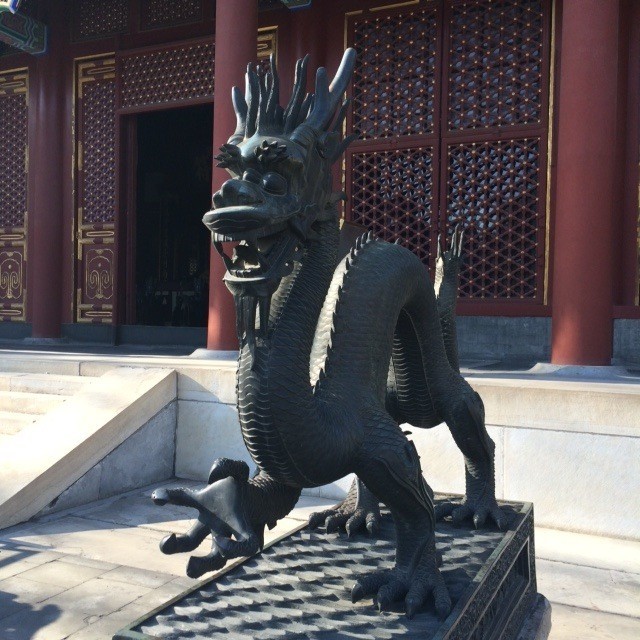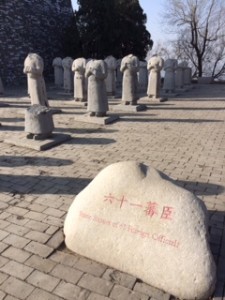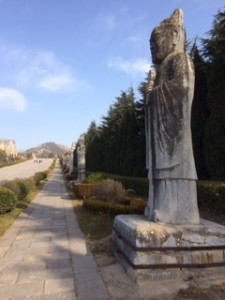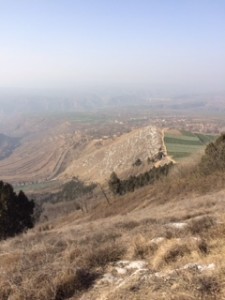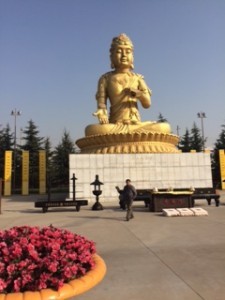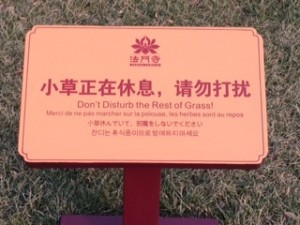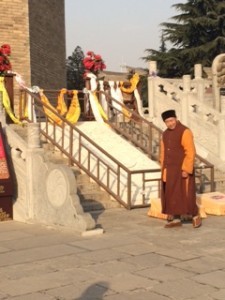Day 4 14th December 2014
Up at a reasonable hour for an outstanding breakfast. All nations catered for – was almost like home, bacon, sausage, beans, egg, and toast (just missing the black pudding). Plus congee and fried devils, sushi, noodles, fresh pastries, etc etc etc.
Today’s itinerary was to see the mausoleum of China’s only woman emperor. Having seen the Temple of Hapsuphet (forgive spelling) in Luxor we seem to be making a habit of this.Anyway, we heard the story of said emperor, Wu Ze Tian. Some strange parallels with Lady Yang in the well-educated concubine from a wealthy mercantile family, plus their own books in the Asiapac series.
A concubine of the Emperor at 14 she formed a relationship with the Emperor’ son. After a “very complicated” life, (which included murdering her daughter and blaming it on the Empress) she became Emperor. On her death she passed power to her son.
Apparently Emperor Wu and her husband have magnificent tombs but for many years the entrance was not found. Some farmers came across the entrance when they were using dynamite. The government came and sealed the entrance with molten steel. Trying to open the tomb attracts the death penalty so I guess Lara Croft won’t be around any time soon. What was on display were the Tang Dynasty statues that line the path to the mountain that houses the tombs.
Winged horses, ostriches, horses and grooms, grim soldiers with long swords, all line the avenue. At the top there are foreign dignitaries giving blessings. Over the years grave robbers have visited, but unable to find the entrance to the tombs, they looked for something else to take. So all the foreign dignitaries are all headless, no doubt being used as door stoppers somewhere.
After the statues, we continue climbing up the mountain. It is pretty steep but the “very handsome” men in the group are constantly stopped for photo opportunities. What the ladies intend to do with the photos goodness only knows. Finally reach the top for panoramic views. Although a little misty, we can see for miles and miles, across a landscape of terraced fields, small towns, railway bridges, back towards the city of Xi’An.
Going back down takes a bit of concentration as the rocks are slippery and the soil powdery. All safely back on the bus, we get the best news of the day – lunch will be at a Buddhist temple so it’s vegan…hooray! We can hardly contain our excitement, but manage somehow, self-control being part of our training.
On the bus I have an enlightening conversation with Jerry about tomb robbers. If the Chinese have such a strong belief in the afterlife, and even enemies will respect each other’s graves, who would break open a tomb and steal? In more ancient times, people would put real food and water, weapons, pots, clothes into graves in the belief that these goods would help in the afterlife. Later on models of such things were put in instead.
More recently, paper effigies of goods are burnt including paper money, cars, even iPhones and wifi access receipts – as clearly that is what modern-day ancestors need to keep up with the times. But grave robbers don’t have scruples about touching dead people’s goods. Apparently they are often family businesses, as otherwise unrelated robbers fall out over the loot and kill each other, leaving the corpse in the tomb. Knowledge amongst such families is extensive, and sometimes archaeologists visit them in prison to ask about artefacts they have found.
Arrive at the newly built Famen Temple complex. Just as we expected, and not in the least contrary to our preconceptions, lunch is tasty though not filling. Vegetables cooked many ways, pretend Chinese sausage, cakes, hot sweet fruit drink, and the famous local noodles. This is an enormous place, the size of a theme park. There is everything about Buddhism here – the Buddha Avenue is lined with gigantic statues of the various sects’ versions of Buddha and acolytes. The Arhat are here, some serene some grim.
Off to the sides hidden among the bushes are statues with meditative areas and information plaques. Chanting is playing on all the speakers lining the avenue as we walk about a mile to reach the pagoda. Even the requests to keep off the grass are framed to ask you to consider the feelings of the grass- I feel like I’m being nudged into being a nice person.
This is a site of pilgrimage for Buddhists as it houses a sacred relic – a finger bone of Sakyamuni. This was thought lost for hundreds of years until it was found in an elaborate crypt beneath the pagoda at the site of the temple. The pagoda had collapsed in the 1980s and in order to reconstruct it the foundations had to be checked. A small passageway was found, which has three sets of stone doors leading into an inner sanctum.
Inside were four caskets, three of which contained “shadow” relics (Buddhists apparently avoiding the word “fake”). The caskets are on display in the museum and are of gold and precious metals, ornately decorated. These contained the shadow relics in a bid to fool any robbers. The real relic was in a plain casket looking modest and unassuming.
As though to make up for its long sojourn in a plain box, the relic is now housed in an enormous pagoda, 184m high. It is not always on sight to the public but we were fortunate to see it. At night the relic retires to a high security vault being a treasure beyond price. It was indeed our lucky day, as were also able to go under the rebuilt pagoda (not the one housing the relic), and visit the crypt. Most interesting was the original entrance, less than 1 metre high, and adult would have to crawl in. The three sets of stone doors were alternately ornately carved or plain. It put me in mind of visiting the crypt of St Francis of Assisi, after visiting the enormous cathedral built over his wooden hut. The elaborate surroundings repel whilst they try to give all the reverence money can buy. But nothing is more impressive than the simplicity which gave rise to such faith. I’m burbling, so I’ll stop here – need to go and meditate on relative values.
That’s enough soul-searching for one day, now you want to know what we had for dinner. Muslim food – special dumplings with the soup on the inside. Plus steamed glutinous rice, spicy potatoes, herbal rice soup (flavoured with a flower essence), lotus roots.
What a day – from the material, manipulative lady Emperor to the contemplative origins of Buddhism in China. Bedtime.
